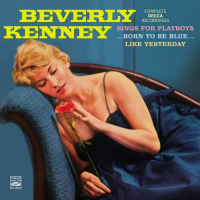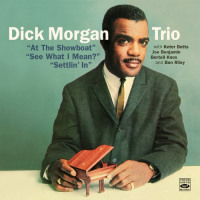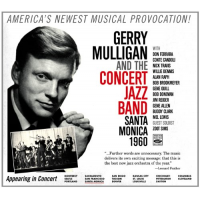Home » Jazz Articles » Record Label Profile » Fresh Sound Records and the Legacy of Recorded Jazz
Fresh Sound Records and the Legacy of Recorded Jazz
 If the importance and the contributions of jazz are measured by its recorded legacy, then Fresh Sound Records—and its founder, Jordi Pujol—must be duly recognized for rescuing a legacy that might otherwise be lost or nearly impossible to find, and for making it available to the public.
If the importance and the contributions of jazz are measured by its recorded legacy, then Fresh Sound Records—and its founder, Jordi Pujol—must be duly recognized for rescuing a legacy that might otherwise be lost or nearly impossible to find, and for making it available to the public. Specifically, this legacy includes recorded works by saxophonist Charlie Parker, trumpeter Louis Armstrong, bandleader and composer Duke Ellington, and literally hundreds of other major, semi-major and lesser known jazz artists who recorded commercially before 1962. Many of these releases might be called "reissues," but Pujol and Fresh Sound make them virtually new by remastering the original tracks if necessary, adding unreleased tracks— sometimes from private recordings, concerts or television tracks—finding newly discovered photographs, conducting interviews with any surviving principals, and commissioning beautifully written and meticulously detailed booklets.
Fresh Sound and Pujol have been doing this since 1983. And while a confessed fan of west coast jazz, as evidenced by his issues of material on labels like Contemporary, he's also released dozens of items from the catalogs of Verve, Riverside, Prestige, RCA (almost 200 releases), New Jazz, Argo, Royal Roost, and almost every other label of every size that recorded jazz.
Because many of Fresh Sound's products are by little-known players by today's standards, these releases cannot be expected to make even a little bit of a profit. It therefore seems that Pujol's criteria for issuing something is simply: He likes it.
That's called integrity. Fresh Sound's newly-released titles stand as a good overview of what the label does and what the label stands for. And though some of these artists may be considered obscure and don't have what we'd call "name value," their musical value is, without exception, considerable.
Vocalists Beverly Kenney, Lucy Ann Polk, Jane Fielding, Helyne Stewart and Marilyn Moore aren't the most recognizable names in jazz, but each of their CDs are very well worth listening to. Repeatedly.
For the most part, these singers came out of the Anita O'Day/June Christy tradition, not without overtones of Doris Day, and all demonstrated a jazz orientation, with "orientation" being the key word. These are not ske-daddling scatters or lyric twisters, but subtle interpreters who improvise by way of inflection and phrasing.
 Beverly Kenney was a sensitive, lyrical and individual jazz stylist who was well on her way to fame when she took her own life at the age of 28 in 1960. Sadly, she sometimes gets more attention for that than she does for her singing. Beverly Kenney: The Complete Decca Recordings is a two-CD set that captures the singer's many unique sides in a number of settings, some blatantly commercial—hey, you've got to sell records—and others in stark surroundings with accompaniment only by the superb piano of Ellis Larkins and bassist Joe Benjamin. Kenney's sound was sort of a Stacey Kent out of Joanie Sommers, little-girlish type of approach that, under the right circumstances—and knowing her tragic history—can really get to you. This one will grow on you. Particularly late at night.
Beverly Kenney was a sensitive, lyrical and individual jazz stylist who was well on her way to fame when she took her own life at the age of 28 in 1960. Sadly, she sometimes gets more attention for that than she does for her singing. Beverly Kenney: The Complete Decca Recordings is a two-CD set that captures the singer's many unique sides in a number of settings, some blatantly commercial—hey, you've got to sell records—and others in stark surroundings with accompaniment only by the superb piano of Ellis Larkins and bassist Joe Benjamin. Kenney's sound was sort of a Stacey Kent out of Joanie Sommers, little-girlish type of approach that, under the right circumstances—and knowing her tragic history—can really get to you. This one will grow on you. Particularly late at night. Talk about obscure. Singer Jane Fielding recorded only two albums in her lifetime, both made in 1956 when she was 21 years old. Little is known about Fielding—some contend she was actually a pro ice skater who hung up the skates due to an injury—but it's clear that, had she stayed in the jazz game, there was a bright future at hand. Her youth comes through at times—let's call her sound "smolderingly youthful"—but her maturity on material that's often difficult is incredible. On tunes like "Embers Glow," "Right Boy for Me" and, believe it or not, "Round Midnight," she is more than confident and clearly feels the lyric. Some of her accompanists aren't too shabby, either, and include saxophonists Teddy Edwards and Joe Maini, bassists Paul Chambers and Red Mitchell and pianist Kenny Drew, who also penned some of the charts. Sound-wise? Think one-half of "Jackie and Roy," Jackie Cain.
Love Moods, first recorded for Contemporary in 1956, highlights singer Helyne Stewart, a protégé and discovery of Teddy Edwards, who led the accompanying group. Stewart, another little-known singer who seemed to have disappeared from the scene after this outing, is a soulful and secure stylist who must have listened to a bit of Carmen McRae and Sarah Vaughan. Stewart has a refreshing purity about her that avoids excess or clichés. The overdone "The Man I Love" is not overdone in Stewart's hands, nor are "How Deep is the Ocean or "That Old Feeling."
And dig who's on the session in addition to Edwards: How about trombonist Frank Rosolino, trumpter Jack Sheldon, alto sax legend Art Pepper, pianist Pete Jolly and bassist Jimmy Bond? Ah...the west coast. CD number two in this same package is a 1961 Edwards session, Good Gravy! featuring pianist Phineas Newborn, Jr., bassist Leroy Vinnegar and drummer Milt Turner. This informal session swings from the start and like the title says, is "Good" indeed.
There are some singers on the scene today who have received a good deal of critical acclaim because of their similarity to Billie Holiday, most notably Madeleine Peyroux. A bunch of writers applauded Diana Ross version of Holiday as well. But in the late 1950s, sounding like Lady Day, intentionally or otherwise, must have been considered a crime of some sort.
The case of Marilyn Moore, heard on Bethlehem's Moody from 1957 and MGM's Oh! Captain! from the year following, was good illustration of that attitude back in the day. Despite great critical reaction—in 1957, the influential Leonard Feather called her "the finest new jazz singer I've heard this year"—that Lady Day albatross and the controversy surrounding it did not help her career.
Holiday is in there, to be sure, but Moore swings like the devil in her own way on items like "Lover Come Back to me," and sings the heck out of a none-to-easy score to the Broadway show, "Oh! Captain." She's backed herein by a group of sympathetic jazz stars, including her then-husband on tenor sax, Al Cohn; bassist Milt Hinton; tenor saxophonist Coleman Hawkins in a rare role as sideman; and no less than the very forward-thinking composer, George Russell, who contributed "Born to Blow" and plays piano on three tracks.
Calling Lucy Ann Polk a jazz singer may be stretching things somewhat. Polk, the best-known of all these singers, gained no small amount of fame from her 1951-1954 stay with the big band of Les Brown. Brown's band, at least in terms of its jazz content, was considered to be at its peak in those years. And Polk rode the crest of the bands' popularity, as she won what was called the best "Girl Band Vocalist" award, given to her by Down Beat magazine for four yeas in a row. She's backed here in three separate sessions from 1953, 1956 and 1957 by groups led by pianist/arranger Marty Paich and saxophonist Dave Pell, and though you can't deny the influence of Doris Day, Polk has a pleasing, secure take—and a much more jazz-oriented one—on the Holiday sound.
Young and aspiring singers should give this a listen. Polk's diction, time and intonation are superb. She swings lightly and politely on 22 standards, with more than appropriate backing by west coasters like trumpeters Shorty Rogers and Don Fagerquist, pianist Claude Williamson, drummers Mel Lewis and Jack Sperling, and Polk's husband, trombonist Dick Noel.
 In 1960, the Washington, D.C.-based pianist Dick Morgan was playing at a club called the Showboat. He so impressed saxophonist Cannonball Adderley during that engagement, that Adderley got Morgan a record date with the Riverside record label. Fresh Sound's Dick Morgan Trio is a two-CD set that includes Morgan's three dates for Riverside.
In 1960, the Washington, D.C.-based pianist Dick Morgan was playing at a club called the Showboat. He so impressed saxophonist Cannonball Adderley during that engagement, that Adderley got Morgan a record date with the Riverside record label. Fresh Sound's Dick Morgan Trio is a two-CD set that includes Morgan's three dates for Riverside. All are characterized by Morgan's funky, swinging and crowd-pleasing style, that seems much closer to that of Bobby Timmons than Morgan's admitted influences, Oscar Peterson and Erroll Garner. This is what they used to call "good time party music," and that it is, especially the live date at The Showboat, complete with out-of-tune piano and happy crowd noises. The then Washington-based bassist Keter Betts plays on two of the three dates from 1960 along with local drummer Bertell Knox. Knox is a killer with brushes, by the way. The 1961 session, recorded in New York, pairs the pianist with the better known Ben Riley on drums and Joe Benjamin on bass.
No matter. Morgan was the centerpiece of these dates, and his happy grooving on standards and a few originals (check the funky "Big Fat Mama") still holds up. As of this writing, the 81-year old pianist, known as the "Dean of Washington, D.C. piano," is still out there wailing.
Tenor saxophonist Brew Moore, who died in 1973, was one of those tragic, nomadic figures in jazz, like Bix Beiderbecke and Chet Baker, who novelists used to romanticize. Indeed, it's been said that some of Moore's more outlandish exploits inspired Jack Kerouac's On the Road (1957). Moore was one of a bunch of Lester Young-inspired tenor saxophonists who maintained, stylistically at least, that Prez was God. Players like Al Cohn, Zoot Sims, Stan Getz, Alan Eager, Herbie Steward and several others outgrew the slavish imitation route. On the other hand, Paul Quinichette made a career of blowing like Prez, so much so, that he was called "The Vice Prez."
Listening to these three, live Moore sessions from 1956, 1957 and 1958—that first came out on two Fantasy LPs—it's evident that the saxophonist still had Lester Young in his heart and head but was slowly becoming his own man. What set him apart, among other things, was his technique (listen to "Them There Eyes"), ability as a blues player (demonstrated on "Them Old Blues," among others), and ease with chord changes.
San Francisco-based for most of his short career, these sessions feature backing by local and/or little known players, including trumpets Dick Mills and another tenor player named Harold Wylie. The bonus track, "Due's Blues," does have some "names" in the rhythm chairs, including Cal Tjader on vibes, Vince Guaraldi on piano and Bobby White on drums.
One thing is for certain, whatever the setting or the backing, Prez influence or not, Brew Moore was one heck of a hard swinger.
The Concert Jazz Band, founded by baritone saxophonist/arranger Gerry Mulligan has taken on celebrated proportions over the years. This "big small band of 13 pieces—as much a showcase for its lightly swinging ensemble sound as it was for its soloists—was formed in 1960. It was a steady band for only two years, though it did work sporadically until 1964 and was revived briefly circa 1978.
 Fresh Sound's two CD-set, Gerry Mulligan and the Concert Jazz Band: Santa Monica 1960, issues, for the first time (Mosaic, a few years ago, released a Mulligan set that contained six of these tracks) the complete live shows held at the Santa Monica Civic Auditorium October 1, 1960. This unit was chock full of fabulous soloists and section-men, including trumpeters Conte Candoli and Nick Travis, trombonist Willie Dennis, trombonist/arranger Bob Brookmeyer, alto saxophonist Gene Quill, tenor saxophonist Zoot Sims and the incredible drumming of Mel Lewis. Given the Maestro's association with his famous, pianoless quartet from the 1950s, there is no keyboard. The inventive and utterly singular charts are by the leader and Brookmeyer, Bill Holman, Johnny Mandel and Al Cohn.
Fresh Sound's two CD-set, Gerry Mulligan and the Concert Jazz Band: Santa Monica 1960, issues, for the first time (Mosaic, a few years ago, released a Mulligan set that contained six of these tracks) the complete live shows held at the Santa Monica Civic Auditorium October 1, 1960. This unit was chock full of fabulous soloists and section-men, including trumpeters Conte Candoli and Nick Travis, trombonist Willie Dennis, trombonist/arranger Bob Brookmeyer, alto saxophonist Gene Quill, tenor saxophonist Zoot Sims and the incredible drumming of Mel Lewis. Given the Maestro's association with his famous, pianoless quartet from the 1950s, there is no keyboard. The inventive and utterly singular charts are by the leader and Brookmeyer, Bill Holman, Johnny Mandel and Al Cohn. This group was so special and so individual that almost everyone wanted to write for it. On famed CJB orchestrations like "The Red Door," the extended "Blue Port" and on the Mulligan "hit" of "My Funny Valentine," the band nicely combines much of what Mulligan had done before as a player and arranger. Of course, the general sound is "cool," a la Mulligan's charts for "Birth of the Cool," and features a good deal of contrapuntal ensemble writing, clearly heard on charts like "Out of this World."
Then there is the ensemble writing and section work that, from time to time—and you never know when—really takes off, a la the leader's earlier charts for bands like Elliot Lawrence and Gene Krupa.
Not enough can be said about this release. Jordi Pujol's notes, by the way, are exemplary and easily guide the listener through the history and the music. It's a pity that this band couldn't continue. But as an interesting sidelight is that about a year after the Concert Jazz Band was history, another big band formed that continued, to an extent, the mission and legacy of the CJB. This new ensemble had the same drummer as Mulligan's band, Mel Lewis, as well as the same trombone soloist and sometimes chart-writer named Bob Brookmeryer. The new band was called The Thad Jones/Mel Lewis Jazz Orchestra.
It is important for anyone interest in jazz and its all-important recorded history to know about Fresh Sound Records.
< Previous
Look Out Now!
Next >
Ritzville
Comments
Tags
Record Label Profiles
Bruce Klauber
Spain
Barcelona
Charlie Parker
Louis Armstrong
duke ellington
Lucy Ann Polk
Helyne Stewart
Marilyn Moore
Anita O'Day
June Christy
Doris Day
Ellis Larkins
Joe Benjamin
Teddy Edwards
Joe Maini
Paul Chambers
Red Mitchell
Jackie Cain
Carmen McRae
Sarah Vaughan
Frank Rosolino
Jack Sheldon
Art Pepper
Pete Jolly
Jimmy Bond
Phineas Newborn
Leroy Vinnegar
Billie Holiday
madeleine peyroux
Diana Ross'
Leonard Feather
Al Cohn
Milt Hinton
Coleman Hawkins
George Russell
Les Brown
Marty Paich
Dave Pell
Shorty Rogers
Don Fagerquist
Claude Williamson
Mel Lewis
Jack Sperling
Dick Morgan
Cannonball Adderley
Bobby Timmons
oscar peterson
Erroll Garner
Keter Betts
Ben Riley
Lester Young
Zoot Sims
Stan Getz
Herbie Steward
Paul Quinichette
Cal Tjader
Vince Guaraldi
Bobby White
Gerry Mulligan
Conte Candoli
Nick Travis
Willie Dennis
Bob Brookmeyer
Gene Quill
Bill Holman
Johnny Mandel
Elliot Lawrence
Gene Krupa
Thad Jones
For the Love of Jazz
 All About Jazz has been a pillar of jazz since 1995, championing it as an art form and, more importantly, supporting the musicians who create it. Our enduring commitment has made "AAJ" one of the most culturally important websites of its kind, read by hundreds of thousands of fans, musicians and industry figures every month.
All About Jazz has been a pillar of jazz since 1995, championing it as an art form and, more importantly, supporting the musicians who create it. Our enduring commitment has made "AAJ" one of the most culturally important websites of its kind, read by hundreds of thousands of fans, musicians and industry figures every month.






















